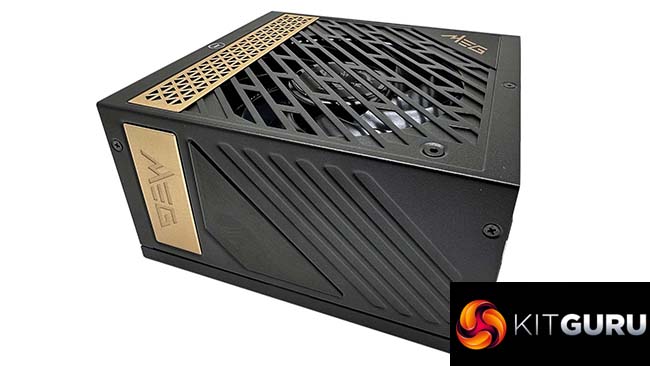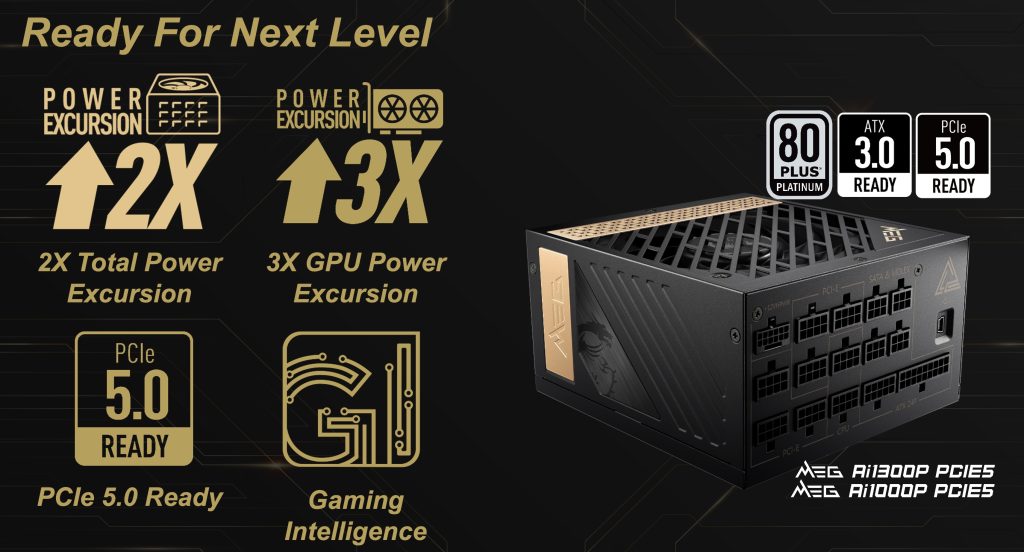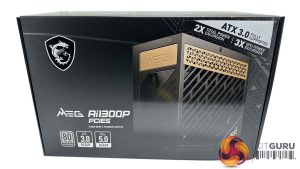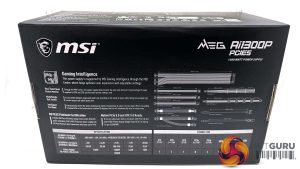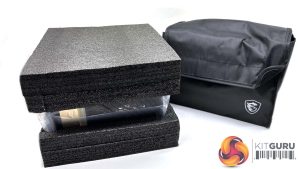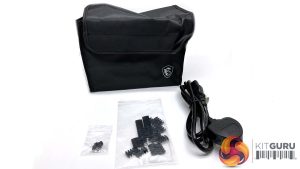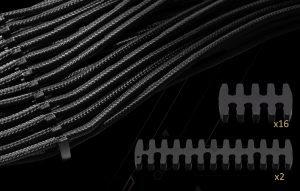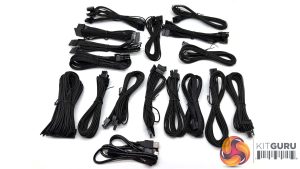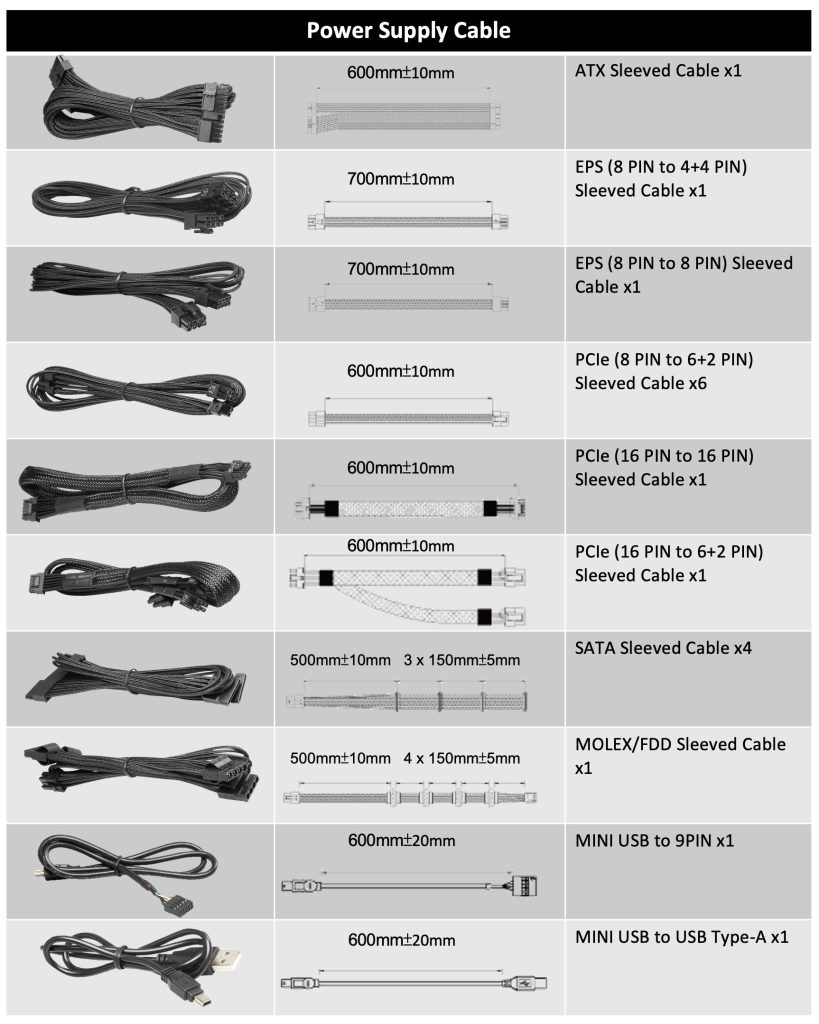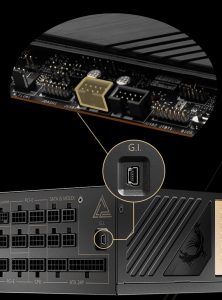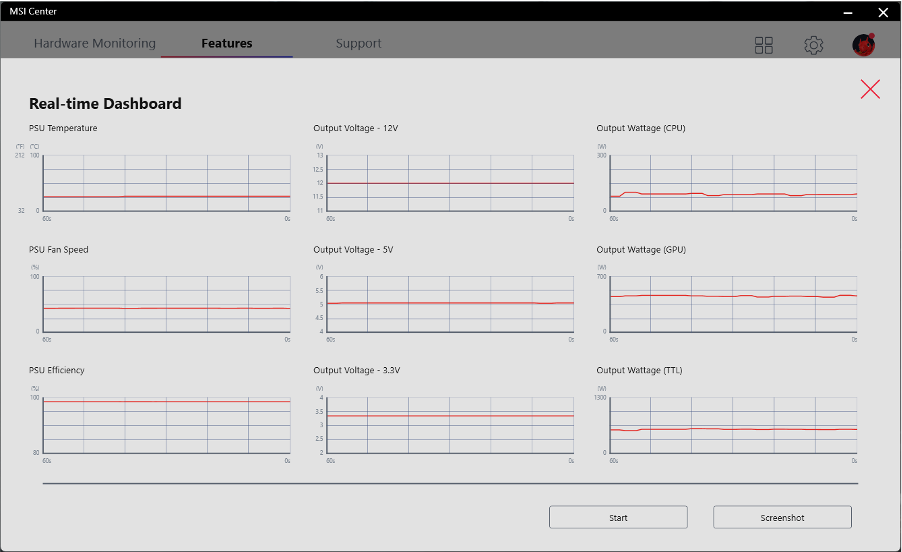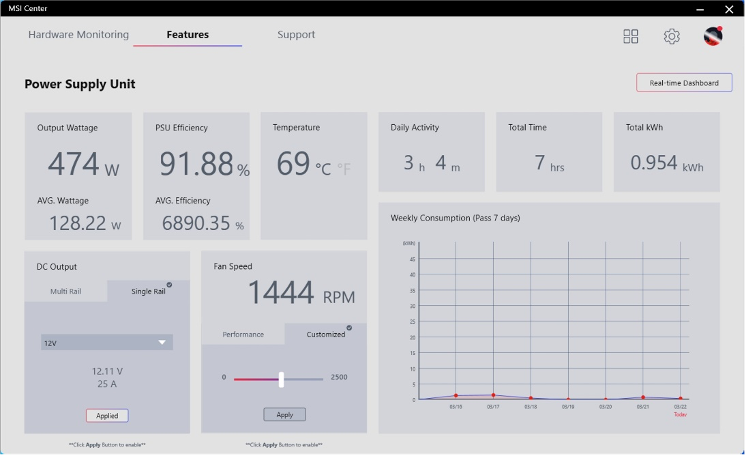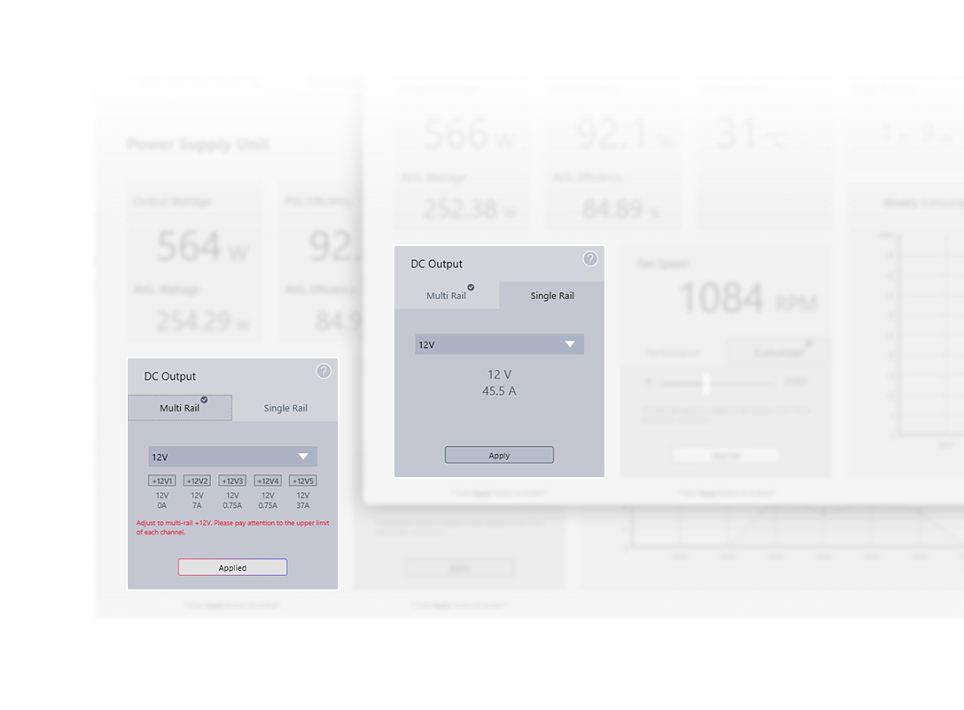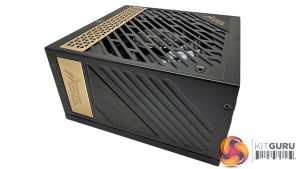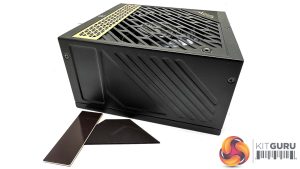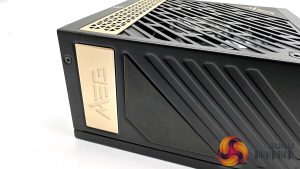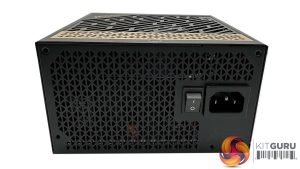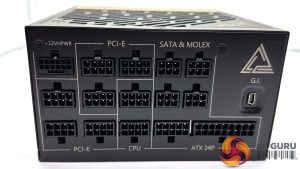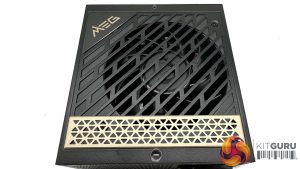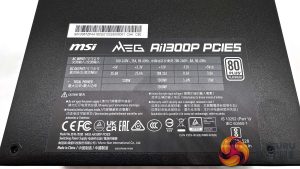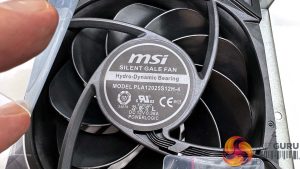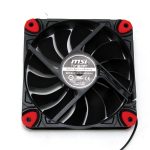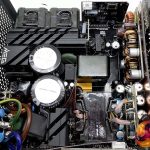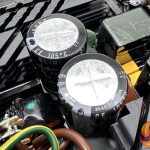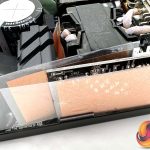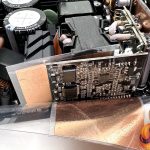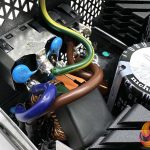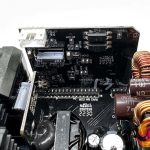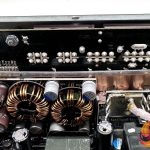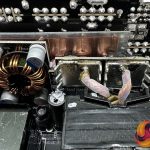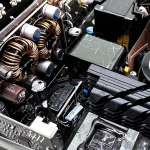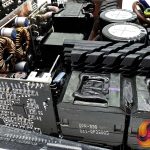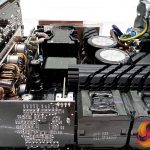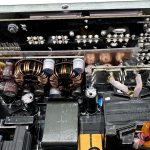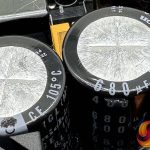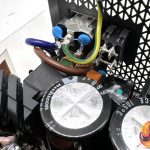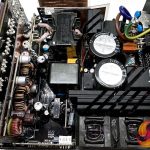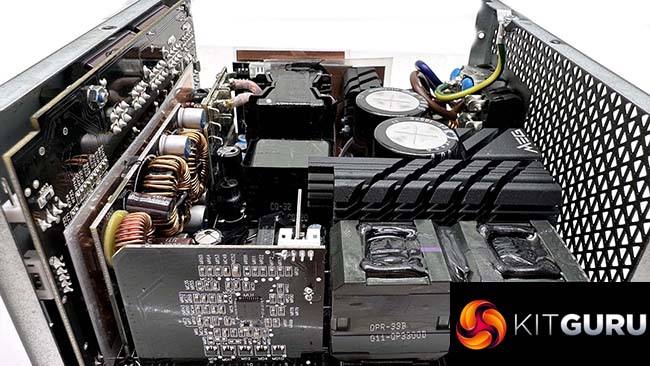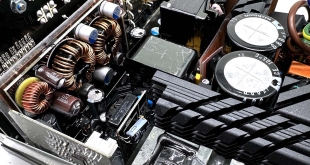
It has been some time since we have analysed a power supply from MSI, and today we are happy to check out their latest Platinum rated fully modular unit, the Ai1300P – priced at around 360 euros. This power supply is ATX 3.0 and PCIe 5.0 ready and MSI say it has 3x GPU power excursion and 2x total power excursion capabilities with a 600W native 16 Pin (12VHPWR) cable included.
MSI have worked with CWT in the design of this power supply and they allow the end user to switch between single and multi rail modes to cover a variety of possible system configurations. MSI support this unit with a 10 year ‘limited' warranty – depending on the region.
When I queried the 10 year warranty terms, I was told the 10 year support does indeed cover the United Kingdom, but I am waiting to hear back on support for other locations globally.
The unit has OCP, OVP, OPP, OTP, SCP and UVP protections and MSI claim 100% Japanese 105c Capacitors throughout – which we will look at later in the review.
Specifications:
- 80 PLUS Platinum Certification
- PCIe 5.0 and ATX 3.0 Ready
- 100% Japanese Electrolytic capacitor
- Full Modular design
- Sleeved Cables
- Active PFC design
- Industrial level protection with OCP,OVP,OPP,OTP, SCP,UVP
- DC-DC Module Design
- MEG SILENT GALE P12 Fan
The MEG Ai1300P arrives in a very attractive box with a high resolution image of the power supply on the front.
The rear of the box highlights some of the key features along with some technical details including the cable configuration.
Inside the outer box is a bag of cables and accessories and the power supply itself, wrapped in a plastic bag, sandwiched between two pieces of foam.
The package contains cable comb managers, a regional specific power connector and mounting screws.
The cables are a mixture of sleeved and custom sleeved to fit into a variety of builds. MSI also supply a MINI USB to USB cable as this power supply can be controlled via MSI software.
MSI call this ‘G.I' (Gaming Intelligence) support. I can't say I really have had great experiences with the MSI software in the past and sometimes it would crash on the test system I used, but the software for the power supply seems to show everything that MSI claim.
MSI's real time power monitor works via the MSI Center app and is useful if you wish to monitor power supplied to the system.
The Features panel highlights wattage, efficiency, temperatures and fan speeds. When the load is below 55% or temperatures are below 70 degrees the fan will automatically stop.
Instead of having a physical switch on the rear of the power supply to toggle between multi rail and single rail, you can control this via the software itself.
We feel this design is going to split opinion. The Asian community tend to love gold accented tech products, the European audience, not so much. It is nicely finished, but I am not a fan of the gold touches.
The MEG power supply measures 86mm x 150mm x 160mm which is somewhat smaller in length than the larger 200mm units we have seen in recent months.
One interesting feature MSI have incorporated- the two panels on the side are held in place magnetically, so they can be easily removed and flipped – depending on your chassis install rotation. This way you get to see the ‘MEG' logo as you want (or you could in theory remove them completely to get rid of some of the gold accenting if you wanted). These do have a tendency to drop off quite easily so you need to be careful when handling the power supply.
One side of the unit is home to the power switch and power socket. This side of the power supply is vented, to help with airflow.
The other side of the power supply houses the modular connectors. The power supply can support current generation graphics cards, and if you pay attention you can see the +12VHPWR connector top left which means you can also connect up a new Nvidia RTX 4000 series graphics card.
The fan is hidden behind a shroud with another gold accented panel. We will take a closer look at this fan when we open the power supply shortly.
We can see the MEG Ai1300P can deliver 108amps to the +12V rail, for a total of 1300 watts.
What can be more Silent than a ‘GALE' you say? Well yes, I can think of quite a few things! We can only imagine the naming for this product was lost somewhere in translation between Asia and Europe.
Regardless of the somewhat daft naming – this 120mm fan has been used by MSI quite extensively since 2016 – under the ‘TORX fan' naming. The model PLA12025S12H-4 has been used with various MSI products, including CPU coolers.
Check this review at Techpowerup for instance from October 2016 of the MSI Core Frozr L cooler. At the bottom of the page we see the same fan, same Model ID, with an older branding.
This fan is a Hydro Dynamic bearing with a good (rated) life span of 50,000 hours. It is a 12V 0.36A unit. These are solid fans, if unremarkable. The ‘Silent Gale' is partly covered by a plastic shroud – in the efforts to direct airflow over specific components underneath.
The CWT design is well put together, soldering quality is high and there are several heatsinks across the PCB to help keep temperatures in check. The power supply uses Japanese capacitors throughout – all 105C rated from well known Japanese companies such as Nichicon. The Primary stage capacitors are rated 680uF 400V, for a total of 1360uF. The power supply supports Over Current Protection, Over Temperature Protection, Over Voltage Protection, Over Power Protection, Under Voltage Protection and Short Circuit Protection.
Correctly testing power supplies is a complex procedure and KitGuru have configured a test bench which can deliver up to a 2,000 watt DC load. Due to public requests we have changed our temperature settings recently – previously we rated with ambient temperatures at 25C, we have increased ambient temperatures by 10c (to 35c) in our environment to greater reflect warmer internal chassis conditions.
We use combinations of the following hardware:
• SunMoon SM-268
• CSI3710A Programmable DC load (+3.3V and +5V outputs)
• CSI3711A Programmable DC load (+12V1, +12V2, +12V3, and +12V4)
• Extech Power Analyzer
• Extech MultiMaster MM570 digital multimeter
• Extech digital sound level meter
• Digital oscilloscope (20M S/s with 12 Bit ADC)
• Variable Autotransformer, 1.4 KVA
12V output is single rail for our testing.
|
DC Output Load Regulation
|
||||||||||
|
Combined |
+3.3V
|
+5V
|
+12V
|
+5VSB
|
-12V | |||||
|
A
|
V
|
A
|
V
|
A
|
V
|
A
|
V
|
A | V | |
|
150W
|
0.90
|
3.33
|
0.84
|
5.03
|
11.65
|
12.03
|
0.5
|
5.01
|
0.20 | -12.02 |
|
300W
|
1.63
|
3.33
|
1.65
|
5.03
|
23.75
|
12.03
|
1.0
|
5.01
|
0.20 | -12.02 |
|
750W
|
3.01
|
3.33
|
3.02
|
5.02
|
59.66
|
12.03
|
1.5
|
5.00
|
0.30 | -12.03 |
| 1125W | 4.05 | 3.33 | 4.05 | 5.01 | 90.00 | 12.02 | 2.0 | 5.00 | 0.30 | -12.02 |
|
1300W
|
8.88
|
3.32
|
8.85
|
5.01
|
98.56
|
11.98
|
2.5
|
5.01
|
0.50 | -12.03 |
Load regulation holds well across the board. Within 2%. This is a very good result for MSI.
| MSI MEG Ai1300P | Maximum Load |
| 1428W |
We managed to get the PSU to achieve 1428W before it would shut down, delivering 128W more than the rated specifications.
Next we want to try Cross Loading. This basically means loads which are not balanced. If a PC for instance needs 500W on the +12V outputs but something like 30W via the combined 3.3V and +5V outputs then the voltage regulation can fluctuate badly.
| Cross Load Testing | +3.3V | +5V | +12V | -12V | +5VSB | |||||
| A | V | A | V | A | V | A | V | A | V | |
| 1150W | 3.0 | 3.33 | 2.0 | 5.03 | 92.0 | 12.02 | 0.2 | -12.03 | 0.50 | 5.01 |
| 250W | 20.0 | 3.31 | 24.0 | 5.00 | 5.0 | 12.03 | 0.2 | -12.02 | 0.50 | 5.01 |
The power supply did very well in our Cross Load tests, indicating a very stable design.
We then used an oscilloscope to measure AC ripple and noise present on the DC outputs. We set the oscilloscope time base to check for AC ripple at both high and low ends of the spectrum.
ATX12V V2.2 specification for DC output ripple and noise is defined in the ATX 12V power supply design guide.
|
ATX12V Ver 2.2 Noise/Ripple Tolerance
|
|
|
Output
|
Ripple (mV p-p)
|
|
+3.3V
|
50
|
|
+5V
|
50
|
|
+12V1
|
120
|
|
+12V2
|
120
|
|
-12V
|
120
|
|
+5VSB
|
50
|
Obviously when measuring AC noise and ripple on the DC outputs, the cleaner it is (less ripple recorded) means we have a better end result. We measured this AC signal amplitude to see how closely the unit complied with the ATX standard.
| AC Ripple (mV p-p) | ||||
| DC Load | +3.3V | +5V | +12V | 5VSB |
| 150W | 5 | 5 | 10 | 5 |
| 300W | 5 | 5 | 10 | 5 |
| 750W | 5 | 10 | 15 | 5 |
| 1125W | 5 | 10 | 15 | 10 |
| 1300W | 10 | 10 | 25 | 10 |
Ripple results are very good across the board, with the +3.3V and +5V rails peaking at 10mV with the +12V rail peaking at 25mV. well within industry rated tolerance parameters.
|
Efficiency (%)
|
|
|
150W
|
91.87
|
|
300W
|
92.57
|
| 750W |
94.23
|
|
1125W
|
93.89
|
| 1300W | 91.78 |
The efficiency ratings are excellent, peaking at around 94.3% and dropping to just below 92% at full load.
We take the issue of noise very seriously at KitGuru and this is why we have built a special home brew system as a reference point when we test noise levels of various components. Why do this? Well this means we can eliminate secondary noise pollution in the test room and concentrate on components we are testing. It also brings us slightly closer to industry standards, such as DIN 45635.
Today to test the power supply we have taken it into our acoustics room environment and have set our Digital Sound Level Noise Decibel Meter Style 2 one meter away from the unit. We have no other fans running so we can effectively measure just the noise from the unit itself.
As this can be a little confusing for people, here are various dBa ratings in with real world situations to help describe the various levels.
KitGuru noise guide
10dBA – Normal Breathing/Rustling Leaves
20-25dBA – Whisper
30dBA – High Quality Computer fan
40dBA – A Bubbling Brook, or a Refrigerator
50dBA – Normal Conversation
60dBA – Laughter
70dBA – Vacuum Cleaner or Hairdryer
80dBA – City Traffic or a Garbage Disposal
90dBA – Motorcycle or Lawnmower
100dBA – MP3 Player at maximum output
110dBA – Orchestra
120dBA – Front row rock concert/Jet Engine
130dBA – Threshold of Pain
140dBA – Military Jet takeoff/Gunshot (close range)
160dBA – Instant Perforation of eardrum
|
Noise (dBA)
|
|
|
150W
|
<28.0
|
| 300W |
<28.0
|
|
750W
|
<28.0
|
|
1125W
|
33.7
|
| 1300W | 37.9 |
The fan in this unit does not spin under most normal load situations. It is only over 1000 watts that the fan makes its presence known, rising in speed at full load to be clearly audible. The pitch of the fan is not annoying, which is beneficial when the load gets in excess of 1,000 watts. At 1,150 watts the noise of the unit ramps up significantly to deal with the demand.
|
Temperature (c)
|
||
|
Intake
|
Exhaust
|
|
|
150W
|
36
|
38
|
|
300W
|
38
|
41 |
|
750W
|
41
|
48
|
|
1125W
|
43
|
53
|
|
1300W
|
44
|
58
|
The fan performs reasonably well, holding temperatures at modest levels throughout the load tests.
|
Maximum load
|
Efficiency
|
|
1428W
|
90.8
|
At 1428W, the efficiency level is around 90.8%.
The MSI MEG Ai1300P is a high performing supply set to target an enthusiast user wanting to power a demanding, modern gaming system. While the somewhat gaudy gold accented styling is likely to split opinion between Asian and European audiences, there is no doubt that technically this unit ticks a lot of boxes.
MSI are trying to attract the user base who love to tinker with their hardware via dedicated software. I appreciate the concept of being able to control a power supply via a program however MSI Center is a clunky, unpleasant tool to use at the best of times. While using MSI Center my only thoughts were to get it deinstalled as soon as possible. I would personally just run the power supply in a default single rail mode mode all the time and let the fans operate automatically without the need for a software install. The other capabilities of MSI Center such as real time monitoring will be interesting to a very niche audience, but perhaps for only a short while.
On a design level, CWT have helped MSI create a very capable unit, able to deliver in excess of 1,400 watts before it safely shut itself down. Ripple suppression is very impressive, and it handled our cross load test without any issues. The adoption of high grade Nichicon 105c rated Japanese capacitors in the primary stage gives peace of mind and it is clear that corners haven't been cut which helps somewhat to justify the 360 euro asking price.
The unit achieved 80 Plus Titanium hitting just over 94% efficiency around 50% load falling to around 92% efficiency at a full load situation.
MSI informed us that UK pricing is not yet set in stone, and considering the terrible stability of the UK economy prices are certainly likely to fluctuate in the coming months. We would expect UK costs to be close to £350 inc vat. While the 10 year ‘limited' warranty has been verified with Kitguru for the United Kingdom we are awaiting MSI's update for warranty terms in other parts of the world. We will update this article when we get confirmation from MSI.
I admit on somewhat of a tangent – I would like to ask MSI to perhaps dial down their marketing a little and focus on the quality of the unit itself more. If you head to their official page for the Ai1300P HERE, you will be continually hit with marketing speak such as ‘The Revelation Of Legend' and ‘The mysterious triangle is a symbolic icon of MEG's infinite power, with the triangle's slope further extending the three pillars of MEG's core characteristics: legendary, loyalty, and luxurious.' While Asian PR has always been somewhat ‘colourful', the marketing for this unit is an utter blitzkrieg of word salad. Are MSI promoting a new Chuck Norris film, or a really well designed power supply? Working through MSI literature in the review of this power supply was rather exhausting, and I will admit, at times, funny.
Pros:
- Solid technical design.
- Runs quiet until 80%+ load.
- 105c Japanese Nichicon capacitors in primary stage. Always good to see.
- delivered over 1,400 watts of power.
- interesting software support ideas.
- ATX 3.0 and PCIe 5.0 Ready.
- good ripple suppression.
Cons:
- This ‘Silent Gale' fan (PLA12025S12H-4) seems to have been around for 6 years under other MSI brand names such as ‘TORX'.
- Word salad promotional marketing galore.
- MSI Center is awful.
- Hideous gold accenting on the chassis.
- can get loud at 1250 watts+
- The magnetic plates tend to fall off too easily on the sides of the chassis.
Kitguru says: The MSI MEG Ai1300P is a high performing power supply with interesting software enhancements that will appease the high end enthusiast audience. This modern design adopts quality internal components with 105c rated Japanese capacitors to help justify the eye watering asking price.
 KitGuru KitGuru.net – Tech News | Hardware News | Hardware Reviews | IOS | Mobile | Gaming | Graphics Cards
KitGuru KitGuru.net – Tech News | Hardware News | Hardware Reviews | IOS | Mobile | Gaming | Graphics Cards


